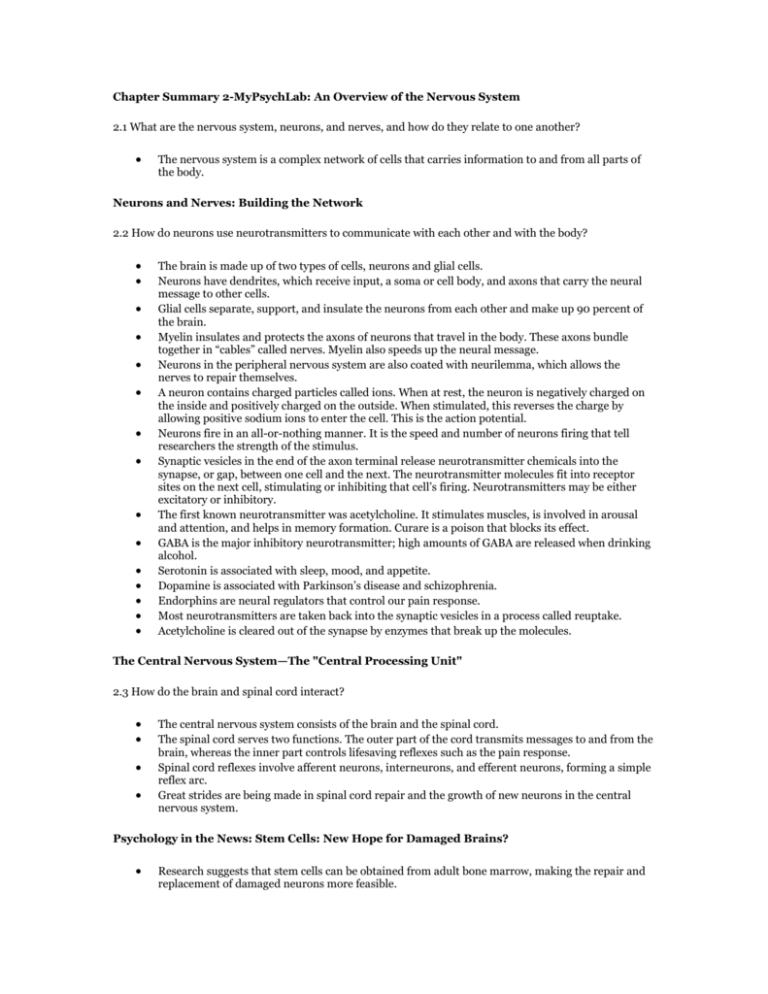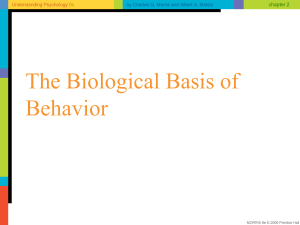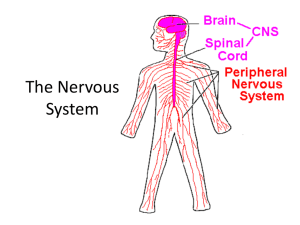Chapter Summary 2-MyPsychLab: An Overview of the Nervous System
advertisement

Chapter Summary 2-MyPsychLab: An Overview of the Nervous System 2.1 What are the nervous system, neurons, and nerves, and how do they relate to one another? The nervous system is a complex network of cells that carries information to and from all parts of the body. Neurons and Nerves: Building the Network 2.2 How do neurons use neurotransmitters to communicate with each other and with the body? The brain is made up of two types of cells, neurons and glial cells. Neurons have dendrites, which receive input, a soma or cell body, and axons that carry the neural message to other cells. Glial cells separate, support, and insulate the neurons from each other and make up 90 percent of the brain. Myelin insulates and protects the axons of neurons that travel in the body. These axons bundle together in “cables” called nerves. Myelin also speeds up the neural message. Neurons in the peripheral nervous system are also coated with neurilemma, which allows the nerves to repair themselves. A neuron contains charged particles called ions. When at rest, the neuron is negatively charged on the inside and positively charged on the outside. When stimulated, this reverses the charge by allowing positive sodium ions to enter the cell. This is the action potential. Neurons fire in an all-or-nothing manner. It is the speed and number of neurons firing that tell researchers the strength of the stimulus. Synaptic vesicles in the end of the axon terminal release neurotransmitter chemicals into the synapse, or gap, between one cell and the next. The neurotransmitter molecules fit into receptor sites on the next cell, stimulating or inhibiting that cell’s firing. Neurotransmitters may be either excitatory or inhibitory. The first known neurotransmitter was acetylcholine. It stimulates muscles, is involved in arousal and attention, and helps in memory formation. Curare is a poison that blocks its effect. GABA is the major inhibitory neurotransmitter; high amounts of GABA are released when drinking alcohol. Serotonin is associated with sleep, mood, and appetite. Dopamine is associated with Parkinson’s disease and schizophrenia. Endorphins are neural regulators that control our pain response. Most neurotransmitters are taken back into the synaptic vesicles in a process called reuptake. Acetylcholine is cleared out of the synapse by enzymes that break up the molecules. The Central Nervous System—The "Central Processing Unit" 2.3 How do the brain and spinal cord interact? The central nervous system consists of the brain and the spinal cord. The spinal cord serves two functions. The outer part of the cord transmits messages to and from the brain, whereas the inner part controls lifesaving reflexes such as the pain response. Spinal cord reflexes involve afferent neurons, interneurons, and efferent neurons, forming a simple reflex arc. Great strides are being made in spinal cord repair and the growth of new neurons in the central nervous system. Psychology in the News: Stem Cells: New Hope for Damaged Brains? Research suggests that stem cells can be obtained from adult bone marrow, making the repair and replacement of damaged neurons more feasible. The Peripheral Nervous System—Nerves on the Edge The peripheral nervous system is all the neurons and nerves that are not part of the brain and spinal cord and that extend throughout the body. There are two systems within the peripheral nervous system, the somatic nervous system and the autonomic nervous system. 2.4 How do the somatic and autonomic nervous systems allow people and animals to interact with their surroundings and control the body's automatic functions? The somatic nervous system contains the sensory pathway, or neurons carrying messages to the central nervous system, and the motor pathway, or neurons carrying messages from the central nervous system to the voluntary muscles. The autonomic nervous system consists of the parasympathetic division and the sympathetic division. The sympathetic division is our fight-or-flight system, reacting to stress, whereas the parasympathetic division restores and maintains normal day-to-day functioning of the organs. Peeking Inside the Brain 2.5 How do psychologists study the brain and how it works? We can study the brain by using deep lesioning to destroy certain areas of the brain in laboratory animals or by electrically stimulating those areas (ESB). We can use case studies of human brain damage to learn about the brain’s functions but cannot easily generalize from one case to another. The EEG allows researchers to measure the electrical activity of the surface of the brain through the use of electrodes placed on the scalp. CT scans are computer-aided X-rays of the brain and show a great deal of brain structure. MRI scans use a magnetic field and a computer to give researchers an even more detailed look at the structure of the brain. A related technique, fMRI, allows researchers to look at the activity of the brain. PET scans use a radioactive sugar injected into the bloodstream to track the activity of brain cells, which is enhanced and color-coded by a computer. From the Bottom Up: The Structures of the Brain 2.6 What are the different structures of the bottom part of the brain and what do they do? The medulla is at the very bottom of the brain and top of the spinal column. It controls lifesustaining functions such as breathing and swallowing. The nerves from each side of the body also cross over in this structure to opposite sides. The pons is above the medulla and acts as a bridge between the lower part of the brain and the upper part. It influences sleep, dreaming, arousal, and coordination of movement on the left and right sides of the body. The reticular formation runs through the medulla and the pons and controls our wakefulness and arousal. The cerebellum is found at the base and back of the brain and coordinates fine, rapid motor movement, learned reflexes, posture, and muscle tone. 2.7 What are the structures of the brain that control emotion, learning, memory, and motivation? The thalamus is the relay station that sends sensory information to the proper areas of the cortex. The hypothalamus controls hunger, thirst, sleep, sexual behavior, sleeping and waking, and emotions. It also controls the pituitary gland. The limbic system consists of the thalamus, hypothalamus, hippocampus, amygdala, and the fornix. The hippocampus is the part of the brain responsible for storing memories and remembering locations of objects. The amygdala controls our fear responses and memory of fearful stimuli. 2.8 What parts of the cortex control the different senses and the movement of the body? The cortex is the outer covering of the cerebrum and consists of a tightly packed layer of neurons about one-tenth of an inch in thickness. Its wrinkles, or corticalization, allow for greater cortical area and are associated with greater intelligence. The cortex is divided into two cerebral hemispheres connected by a thick band of neural fibers called the corpus callosum. The occipital lobes at the back and base of each hemisphere process vision and contain the primary visual cortex. The parietal lobes at the top and back of the cortex contain the somatosensory area, which processes our sense of touch, temperature, and body position. Taste is also processed in this lobe. The temporal lobes contain the primary auditory area and are also involved in understanding language. The frontal lobes contain the motor cortex, which controls the voluntary muscles, and are also where all the higher mental functions occur, such as planning, language, and complex decision making. 2.9 What parts of the cortex are responsible for higher forms of thought, such as language? Association areas of the cortex are found in all the lobes but particularly in the frontal lobes. These areas help people make sense of the information they receive from the lower areas of the brain. An area called Broca’s area in the left frontal lobe is responsible for producing fluent, understandable speech. If damaged, the person has Broca’s aphasia in which words will be halting and pronounced incorrectly. An area called Wernicke’s area in the left temporal lobe is responsible for the understanding of language. If damaged, the person has Wernicke’s aphasia in which speech is fluent but nonsensical. The wrong words are used. Classic Studies in Psychology: Through the Looking Glass: Spatial Neglect Spatial neglect comes from damage to the association areas on one side of the cortex, usually the right side. A person with this condition will ignore information from the opposite side of the body or the opposite visual field. 2.10 How does the left side of the brain differ from the right side? Studies with split-brain patients, in which the corpus callosum has been severed to correct epilepsy, reveal that the left side of the brain seems to control language, writing, logical thought, analysis, and mathematical abilities. The left side also processes information sequentially. The right side of the brain processes information globally and controls emotional expression, spatial perception, recognition of faces, patterns, melodies, and emotions. The Chemical Connection: The Endocrine Glands 2.11 How do the hormones released by glands interact with the nervous system and affect behavior? Endocrine glands secrete chemicals called hormones directly into the bloodstream, influencing the activity of the muscles and organs. The pituitary gland is found in the brain just below the hypothalamus. It has two parts, the anterior and the posterior. It controls the levels of salt and water in the system and, in women, the onset of labor and lactation, as well as secreting growth hormone and influencing the activity of the other glands. The pineal gland is also located in the brain. It secretes melatonin, a hormone that influences the sleep–wake cycle in humans and some animals in response to changes in light. The thyroid gland is located inside the neck. It controls metabolism (the burning of energy) by secreting thyroxin. The pancreas controls the level of sugar in the blood by secreting insulin and glucagons. Too much insulin produces hypoglycemia, whereas too little causes diabetes. The gonads are the ovaries in women and testes in men. They secrete hormones to regulate sexual growth, activity, and reproduction. The adrenal glands, one on top of each kidney, control the stress reaction through the adrenal medulla’s secretion of epinephrine and norepinephrine. The adrenal cortex secretes over 30 different corticoids (hormones) controlling salt intake, stress, and sexual development. Applying Psychology to Everyday Life: Reflections on Mirror Neurons Italian scientist Rizzolatti and colleagues discovered the existence of mirror neurons, neurons that not only fire when performing an action but also fire when the organism merely watches an action being performed by another. Mirror neurons may explain much of human social interaction, and may be useful in understanding disorders such as autism. There may also be practical applications in the treatment of stroke patients who need to regain lost skills and in therapy for psychological disorders such as depression.








